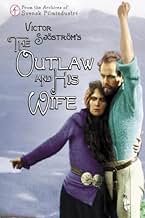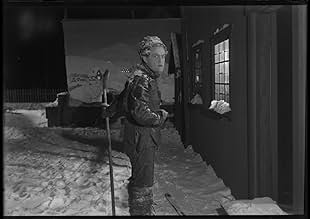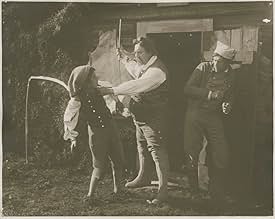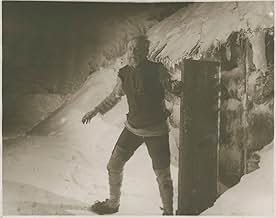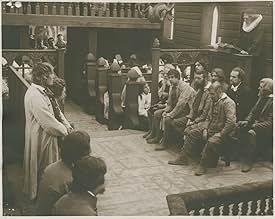CALIFICACIÓN DE IMDb
7.1/10
2.2 k
TU CALIFICACIÓN
Agrega una trama en tu idiomaEjvind and his family are in need of food. So Ejvind seeks help from the rich priest next door. He refuses to help. Ejvind then steals a sheep from the priest, he is caught. But he escapes f... Leer todoEjvind and his family are in need of food. So Ejvind seeks help from the rich priest next door. He refuses to help. Ejvind then steals a sheep from the priest, he is caught. But he escapes from prison, and becomes an outlaw.Ejvind and his family are in need of food. So Ejvind seeks help from the rich priest next door. He refuses to help. Ejvind then steals a sheep from the priest, he is caught. But he escapes from prison, and becomes an outlaw.
- Dirección
- Guionistas
- Elenco
Walerie Alexandrow-Höök
- Berg-Ejvinds och Hallas dotter Tota
- (as Walerie Alexandrow)
- Dirección
- Guionistas
- Todo el elenco y el equipo
- Producción, taquilla y más en IMDbPro
Opiniones destacadas
(1918) The Outlaw and His Wife/ Berg-Ejvind och hans hustru
SILENT DRAMA
Co-written, directed and starring Victor Sjöström, he plays an unknown drifter, Kari (Victor Sjöström) looking for work and ends up working at a farm, owned by Halla (Edith Erastoff). And as they begin to fall in love, it is then his past begins to catch up with him that his name is not Kari, but is really Eyvind suspected of escaping from prison. Adapted from the play "Eyvind of the Hills" by Jóhann Sigurjónsson.
A silent Swedish film that is reminiscent of a serious love story that has a complicated situation, that can be used as a basis for movies that come after it.
Co-written, directed and starring Victor Sjöström, he plays an unknown drifter, Kari (Victor Sjöström) looking for work and ends up working at a farm, owned by Halla (Edith Erastoff). And as they begin to fall in love, it is then his past begins to catch up with him that his name is not Kari, but is really Eyvind suspected of escaping from prison. Adapted from the play "Eyvind of the Hills" by Jóhann Sigurjónsson.
A silent Swedish film that is reminiscent of a serious love story that has a complicated situation, that can be used as a basis for movies that come after it.
It's hard to imagine, but only a few years before this film debuted, most films were only a few minutes long. And, full-length films really were a pretty new thing. So, to see a long, complex and cinematic film like "You and I" shows just how far the industry had grown. Victor Sjöström plays a man who is on the run from the law. Years earlier, he'd been sent to prison for stealing a sheep to feed his family and he'd eventually broken out of a tiny make-shift prison in Iceland. The film picks up when he's on the run in the interior of the country--looking for work and hoping no one recognizes him. In the process, a woman takes him in to work on her farm and eventually the two fall in love....at about the time the law shows up to claim him. The two run off together and live in the inhospitable wilds for the next 17 years (yikes). Exactly what happens is something you'll just need to see for yourself--but it does have some nice surprises.
The film is well worth seeing mostly for the nice acting and cinematography. Interestingly, in addition to starring in the film, Sjöström directed and co-wrote this film--and the look of the film can clearly be attributed to him. I also appreciate how he was able to recreate the look of Iceland nicely by apparently filming in the middle of no where AND in pretty inhospitable weather. A very good film--and it has some nice things to say about crime and punishment.
The film is well worth seeing mostly for the nice acting and cinematography. Interestingly, in addition to starring in the film, Sjöström directed and co-wrote this film--and the look of the film can clearly be attributed to him. I also appreciate how he was able to recreate the look of Iceland nicely by apparently filming in the middle of no where AND in pretty inhospitable weather. A very good film--and it has some nice things to say about crime and punishment.
It is a truism that Victor Sjostrom's films dramatise the conflict between nature and society, but his treatment is less simplistic than might be first apparent. For instance, society in 'The Outlaw and his Wife' is ruled by a brutal, land-grabbing Bailiff who whips servants for losing a sheep; but it is also a place rich in pageantry, costume and rite, where communities can express themselves.
Similarly, nature might be a site of freedom for social outsiders, a sustaining idyll for lovers, and an awe-inspiring backdrop, but it also overflows in the lonely vagrant who comes close to rape, or the cliff and snows that can kill.
Throughout Sjostrom shifts impressively between registers - nature as both real presence and symbolic backdrop; plot as both social depiction and spiritual journey - while retaining familiar action pleasures.
Similarly, nature might be a site of freedom for social outsiders, a sustaining idyll for lovers, and an awe-inspiring backdrop, but it also overflows in the lonely vagrant who comes close to rape, or the cliff and snows that can kill.
Throughout Sjostrom shifts impressively between registers - nature as both real presence and symbolic backdrop; plot as both social depiction and spiritual journey - while retaining familiar action pleasures.
On my continued journey through silent film from the early 20th century, this is my favorrite one yet. I found the changing colors much less distracting, and at points even felt like the colors added to the tone of the scene. I particularly enjoyed the costumes in this film, and found the plot much easier to follow than other films of this category. I enjoyed seeing a strong female character, unlike in 'A Man There Was'. There are both laughs and cries throughout this film, and the ending I thought was beautiful. The title cards consisted of more dialogue than I'd seen in previous films, which helped to make the plot more understandable.
Natural surroundings heighten a movie director's ability to examine his characters' identities. The first film in cinema to introduce soaring landscapes and weather elements for the purpose of exploring the actors' interior personalities is Swedish director Victor Sjostrom's January 1918 "The Outlaw and His Wife."
Based on the true story of a mid-1700 criminal escaping incarceration with his wife into the mountains of Iceland, "The Outlaw and His Wife" uses the stunning scenery of northern Sweden to reflect nature's impact on human behavior, especially displayed in the second half of the movie.
Sjostrom and Edith Erastoff appeared in the director's earlier "The Man There Was," and began a relationship despite Erastoff marriage status. In fact, Edith was pregnant with Sjostrom's child when filming "The Outlaw and His Wife." She delivered a girl, Guje Lagerwall, who lived to be 100, soon after the January premier. Sjostrom and Erastoff eventually married in 1922 after she secured a divorce from her first husband.
Sjostrom worked well with cinematographer Julius Jaenzon, who lends a surreal tone to this highly visual film. He uses the sun frequently to backlight the actors, and often overexposes the film to portray them in a fairytale-like glow. Jaenzon also silhouettes his on-camera personalities against huge backdrops to emphasize how puny people and their problems are in relation to the overall scheme of God's great work in presenting earth's majesty.
Besides man's co-existing with a sometimes turbulent nature, Sjostrom shows the psychological mechanics within a human relationship, especially reflected memorably in the sequence where Erastoff throws the couple's baby over the cliff. Such stress in hiding from the law in an unforgiving environment casts a light on the breaking point of the human condition in such circumstances.
Today's directors such as Terrance Malick, known for his photographic expertise, studied "The Outlaw and His Wife" for its natural elements incorporated into their characters' behavior and plot motivations. Sjostrom's film played a huge influence on later visually-stunning motion pictures using nature's varied landscapes.
Based on the true story of a mid-1700 criminal escaping incarceration with his wife into the mountains of Iceland, "The Outlaw and His Wife" uses the stunning scenery of northern Sweden to reflect nature's impact on human behavior, especially displayed in the second half of the movie.
Sjostrom and Edith Erastoff appeared in the director's earlier "The Man There Was," and began a relationship despite Erastoff marriage status. In fact, Edith was pregnant with Sjostrom's child when filming "The Outlaw and His Wife." She delivered a girl, Guje Lagerwall, who lived to be 100, soon after the January premier. Sjostrom and Erastoff eventually married in 1922 after she secured a divorce from her first husband.
Sjostrom worked well with cinematographer Julius Jaenzon, who lends a surreal tone to this highly visual film. He uses the sun frequently to backlight the actors, and often overexposes the film to portray them in a fairytale-like glow. Jaenzon also silhouettes his on-camera personalities against huge backdrops to emphasize how puny people and their problems are in relation to the overall scheme of God's great work in presenting earth's majesty.
Besides man's co-existing with a sometimes turbulent nature, Sjostrom shows the psychological mechanics within a human relationship, especially reflected memorably in the sequence where Erastoff throws the couple's baby over the cliff. Such stress in hiding from the law in an unforgiving environment casts a light on the breaking point of the human condition in such circumstances.
Today's directors such as Terrance Malick, known for his photographic expertise, studied "The Outlaw and His Wife" for its natural elements incorporated into their characters' behavior and plot motivations. Sjostrom's film played a huge influence on later visually-stunning motion pictures using nature's varied landscapes.
¿Sabías que…?
- TriviaBased on the story of Eyvindur of the Mountains (1714-1783), an outlaw in Iceland who fled into the mountains with his wife around 1760 and remained there for twenty years.
- Versiones alternativasTurner Classic Movies has shown on TV a restored version copyrighted in 1968 by Svenska Filminstitutet (The Swedish Film Instute). The restoration credits are in Swedish, but some of the original cast and crew credits are in English. All intertitles are in English and the film runs 73 minutes.
- ConexionesFeatured in Victor Sjöström - ett porträtt av Gösta Werner (1981)
- Bandas sonorasKung Kristian II, op. 27
Composed by Jean Sibelius (1898)
Selecciones populares
Inicia sesión para calificar y agrega a la lista de videos para obtener recomendaciones personalizadas
- How long is Berg-Ejvind och hans hustru?Con tecnología de Alexa
Detalles
- Fecha de lanzamiento
- País de origen
- Sitio oficial
- Idioma
- También se conoce como
- The Outlaw and His Wife
- Locaciones de filmación
- Nuolja, Abisko, Suecia(mountain scenery)
- Productora
- Ver más créditos de la compañía en IMDbPro
Taquilla
- Presupuesto
- SEK 100,000 (estimado)
- Tiempo de ejecución
- 1h 12min(72 min)
- Mezcla de sonido
- Relación de aspecto
- 1.33 : 1
Contribuir a esta página
Sugiere una edición o agrega el contenido que falta

